Introduction
For the modern day’s balance between the development and conservation of the environment has to be inculcated. The environmental clearances will do a different balancing act to ensure the ecosystem does not get confused. This article covers What Is Environmental Clearance, its aims, and the process of how to acquire it in India.
Government Regulations for Project Clearance
For over 300 years now, since the Industrial Revolution, the whole world has turned its attention from the concerns and issues of the environment to those of their personal gains and pursuit of interests. Such transformation implies revisions in our way of life and the world surrounding us.
Thus, environmental awareness and care are reduced with time. To tackle this phenomenon, several acts and legislations have been enforced in the Indian constitution.
The first environmental Law in India was The Shore Nuisance (Bombay and Kolaba) Act, of 1853 and this was followed by the development of more environmental laws in coming years. One example of such regulation is the Environmental Clearance Regulation which prevents public activities to protect nature.
Environmental clearance applies to a state procedure in India and globally. The country began its process of environmental assessment of river valley projects in 1978-79.
The framework has since grown to accommodate different sectors other than its original targets. These developmental areas consist of projects related to thermal power, mining schemes, industries, and more.
The Ministry of Environment, Forest and Climate Change (MoEFCC) is the central authority responsible for environmental regulation in India. Obtaining environmental clearance is mandatory for specific types of projects before construction or operation can begin. This process ensures potential environmental impacts are identified, assessed, and mitigated.
What is Environmental Clearance Regulation?

Environmental Clearance is a procedure in which government approval is obtained for some projects, either new like new objects or existing projects with some amendments or addition of new structures. This is normally required for projects where there is the potential to cause major harm to the environment or that are going to pollute the environment.
It would be more relevant for areas that are ecologically sensitive, regardless of whether the project is an on-restore one or an off-reef one.
Environmental Clearance in India stands as the continuous process of Environmental Impact Assessment (EIA) of various development projects. The government has made up a list of projects that are subject to environmental impact assessment because of high pollution levels.
Both the Central Government and the State Governments have got power to supervise and regulate this process.
Objectives of Environmental Clearance
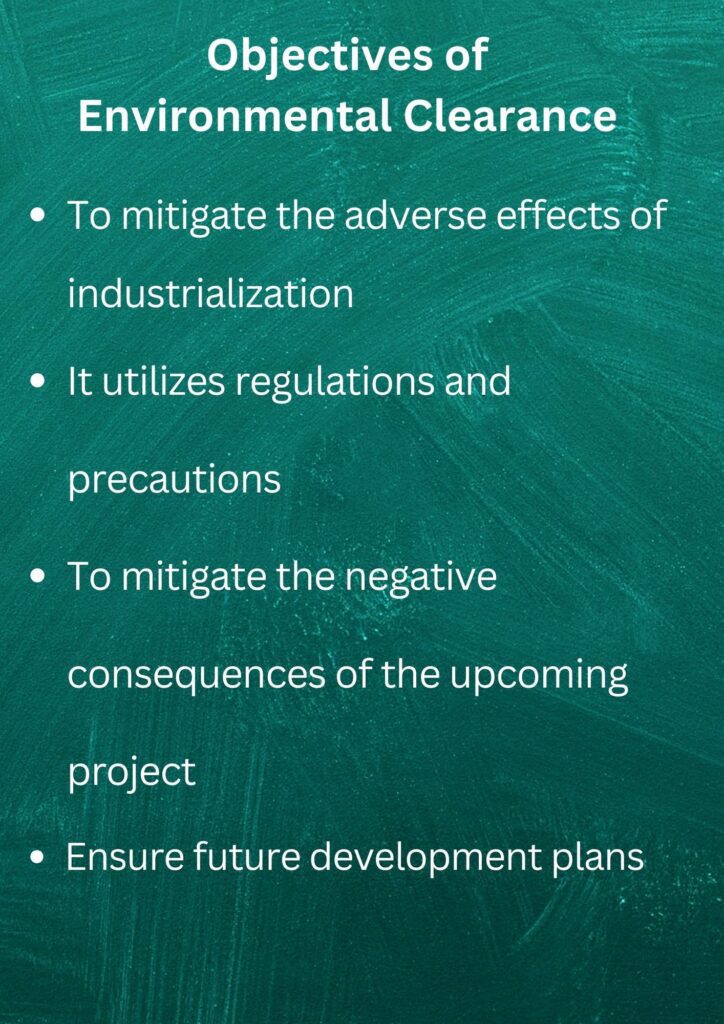
The following are the important objectives of environmental clearance:
- The main aim of environmental clearance is to check the adverse effects of industrialization over the years which are a result of the fact that people have not taken the environment very seriously.
- To help the environment using environmental regulations and precautions.
- Another important point of Environmental Clearance is that the assessment should cover the effects of that development on the environment and the people.
- Besides that EIA Report, also wants to mitigate the negative consequences of the upcoming project by proposing alternatives and effective preventive measures.
- The Environmental Clearance Agents are responsible for ensuring that no public and environmental costs result from future development plans.
Environmental Impact Assessment (EIA)
Environmental Impact Assessment (EIA) can be mentioned as one of the most efficient instruments that can be applied to be confident that all the environmental aspects will be taken into consideration and that the development will start from the very beginning. It makes sure that development is being done keeping in mind the environment causes no or minimal planning of the project and makes sure that all strategies are induced to save the environment damage to the environment in the process of development.
EIA exists in the initial stages of from the beginning stages of industrialization, etc. In short, the EIA can be referred to as a detailed evaluation and study of the likely environmental impacts and impactful outcomes that may result from the upcoming projects.
Important Acts to Restrict Environmental Damage

There are several important Acts in place to restrict and control environmental damage.
- The Environment (Protection) Act, 1986
- The Biological Diversity Act, 2002
- The National Environmental Tribunal Act, 1995
- National Green Tribunal Act, 2010
- The National Environment Appellate Authority Act, 1997
- Types and Categories of Environmental Clearance Regulation
For instance, a mandatory impact study by at least 39 varieties of industrial projects is troubling. The analysis aims to quantify the degree of impact of the project on the environment and whether it can be contaminated. Yet, counteraction is undertaken in case these are too great.
Classification of projects for environmental clearance
Category A
Projects must get environmental clearance before they can be built and run. Usually, these projects can’t move forward without passing the screening process and getting the green light. These projects are sent to the Ministry of Environment, Forest and Climate Change for approval.
Large Industrial Projects like steel, cement, mining, thermal power plants, refineries, and petrochemical complexes Infrastructure Development like highways exceeding a certain length, airports, major irrigation projects, and ports
Category B
These upcoming projects undergo a mandatory screening process. They approach the State Government to obtain clearance. Projects falling under this category are further categorized
Into two types B1 & B2. The only difference between these two also is that B2-type projects do not need to carry out preparation of the EIA Report. Alternatively, in keeping with the nature of the project, the Appraisal Board may decide to conduct an EIA study.
Medium-sized industries like sugar, pharmaceuticals, textiles, and River Valley Projects like Hydroelectric power plants with a capacity below a certain limit, irrigation projects with a smaller command area
Industrial projects that are identified in specific geographic regions will be required to obtain environmental authorization irrespective of their nature. they are:
- Archaeological monuments
- Scenic areas
- Religious and Historic places
- Beach resorts
- Hill resorts
- Coastal areas that are characteristically dense with mangroves, play a great role in the reproduction of specific target species.
- Gulf areas
- Estuaries
- Biosphere reserves
- National lakes and swamps
- National Parks and sanctuaries
- Seismic Zones
- Areas of scientific and geological interests
- Tribal Settlements
- Defense installations
- Border areas
- Airports
These areas are designated as ecologically fragile and sensitive; thus, environmental clearance is compulsory for them.
Environmental compliance restrictions imposed on the SSI Sector.
Industrialists who plan to set up projects should get statutory permission related to Pollution Control and Environment. As per a notice published under the Environment Protection Act, 1986 (SO 60(E) dated 27/1/94) there is a project list containing 29 projects which have to be forwarded for obtaining clearance from the Ministry of Environment, Government of India.
This includes various industries such as petrochemical complexes, petroleum refineries, cement factories, thermal power plants, bulk drug manufacturers, fertilizer producers, dye makers, paper mills, and more.
But, if the investment is smaller than 500 million (excepting pesticides, bulk drugs, and pharmaceuticals, asbestos and asbestos products, integrated paint complexes, mining projects, tourism projects falling under specific criteria, tar roads in Himalayan regions, distilleries and dye-producing factories, foundries, electroplating industries), FDI will have nothing to worry about.
Additionally, any item that falls under the small-scale sector and requires an investment of less than 10 million is also not required to obtain environmental clearance from the Central Government as stated in the Notification. To reduce the number of thermal power plants that can be directly started without environmental clearance, the State Government has been authorized to grant environmental clearance certificates for some specific types of thermal power plants.
Industries in areas sensitive to the environment like the Aravalli Range, coastal regions, Doon Valley, Dahanu, etc., have been given guidelines, especially by the Ministry of Environment of the Government of India.
The Government of India has rationalized and simplified environmental clearance procedures for small-scale industries except in the case of 17 hazardous industries. It is sufficient for the State Environment Board to be aware of the application just for small-scale industries (SSIs).
The seventeen hazardous items are:
- Fertilizer (Nitrogen/Phosphate)
- Cement
- Aluminum
- Thermal power
- Sulphuric acid
- Copper Smelter
- Iron and Steel
- Dye and Dye intermediaries
- Basic drugs and Pharmaceuticals.
- Procedure for Environmental ClearanceSugar
- Fermentation of Distillery
- Petrochemicals
- Oil refinery
- Tanneries
- Zinc Smelter
- Pulp and paper
- Pesticide manufacturing and formulation
Steps to Get Environmental Clearance
The following steps are to be followed mandatorily to get Environmental Clearance for a proposed project:
1. Identification of the Location
The location for the proposed project should always be selected according to which it should comply with the existing guidelines. If the project location doesn’t meet the guidelines, the person proposing the project must find a different site that follows the rules.
2 Screening
First things first, the owner/operator of the facility should determine the category of the project. Then the proponent has to decide whether or not the project requires an environmental clearance, whether or not it requires an Environment Impact Assessment (EIA), and by whom, according to the category of the project.
In the case of notification falling under the notification’s schedule, an Environmental Impact Assessment Study ensues. The B-category projects are finally forwarded to the State Government for final approval of B1 and B2 projects. B2 projects are often less capital-intensive and thus do not warrant an EIA report.
4. Assessment
After the EIA report is prepared, the investor approaches the State Pollution Control Board (SPCB) and State Forest Department (SFD) (in the case of forest land) for further approvals. The SPCB determines the effluents and control measures indicated by the investor. If the requirements are met, the NOC is issued which is valid for the next 15 years.
5. Public Hearing
Some projects call for a public hearing as part of environmental evaluation. This is an important step in the Environmental Impact Assessment (EIA) process. It allows the local community to directly engage with both the project proponent and the government, allowing them to voice their concerns and opinions regarding the proposed project.
In this process, SPCB gives a public hearing before the issue of District Collector chairs the Organizing Committee for the Public Hearingtor. Along with them, some other committee members include officials from the district development agency, the SPCB, the Department of Environment and the Forests, a Taluk representative, a Gram Panchayat member, and a senior citizen of the district.
The next step is when the committee allows for the public to have objections and suggestions. The next step of this process is voting at the Ministry of Forest and Environment when certain paragraphs have been contained within the proposal.
6. Application
The person in charge of the project sends an application to the Ministry of Environment and Forests (MOEF) if it belongs to the Project A category, or the State Government if it belongs to the Project B category.
The proponents have to submit the filled-in application along with the EIA report, EMP, details of the public hearing, and NOC obtained from the concerned state regulators. The application has to be filled out online. In the case of an online application for environmental clearance, the applicant must submit the application form.
7. Environmental Appraisal
The investor’s application is studied by the Ministry of Environment and Forests which comprises specialists who work in different fields. In such cases, a site visit may be used, if needed. The next step is to subject the proposals and the EIA review to the expert committees notified under the EIA Notification.
These committees, called Environmental Appraisal Committees, are formed for different sectors such as River Valley, Industries, Mining, etc. They report their findings on the bidding regularly.
During the planning of some particular or critical projects that have attracted public attention, the suitable committee would hold public hearings so that public participation in decision-making would be ensured. The dates of the public hearings must be publicized in newspapers with at least 30 days’ advance announcements.
The committees develop recommendations depending on their findings, which would be either to approve or reject the project. Hence, these recommendations are forwarded to the Ministry of Environment and Forests for final use or rejection.
8. Clearance or rejection letter
In case a project needs clearance and consent under the Forest (Conservation) Act, 1980, the authorities should receive the applications of both regulations at a time. This process is done at the same time as the cleared or rejected letter is issued, but there may be separate written statements.
If there is no forest land diversion is the scenario the case will be processed only through environmental clearance.
After receiving all the necessary documents and data from the project authorities, and conducting public hearings if necessary, the project’s impact on the environment is thoroughly assessed and evaluated and the environment angle is completed Within 90 days the entire procedure is carried out and the board’s decision must be conveyed within 30 days from the submission of the application.
The given license becomes valid for five years, the time frame for commencement of construction or operation of the project. The permission given will remain valid for five years from the start of the project’s construction or operation.
Role of Various Stakeholders in the Environmental Clearance Process
In the Indian environmental clearance process, the community plays the leading role in developing and operating a project whose work is directly related to the protection of the environment. Let’s take a closer look at what they do
- Project Proponent: They are the ones who are saying that the project should be undertaken or it should be undertaken by the company. These agencies start the environmental clearance process through the submission of the necessary documents and implementation of measures to mitigate the generalization of environmental impacts as determined in the EIA report.
- Government Authorities: The Ministry of Environment, Forest, and Climate Change looks after the Category A projects, and the State Environment Impact Assessment Authorities (SEIAAs) are accountable for Category B projects. In their task, they examine the EIA reports very carefully, call out for a public hearing, and determine the final decision on whether the environmental permit will be granted or not depending on environmental regulations.
- Expert Appraisal Committees (EACs): It is the MoEFCC that creates this committee, and these committees consist of people with different backgrounds and hold a place of importance in the field of environment. They offer some technical guidance and assess for Category A projects the drafted EIA reports, sustaining a constructive dialogue on the conflict-sensitive decision-making
- Public: The environment in which the project will be implemented allows local communities, which are likely to be affected, to participate as well. Through public hearings, communities are allowed to air their fears and suggest remedies that can be applied to mitigate geographical and social risks.
- Non-Governmental Organizations (NGOs): The NGOs that work on environmental issues play a necessary role in the drive for the conservation of our environment. They can be part of public hearings, give awareness on possible environmental issues, and track down the project proponents’ movements.
- Financial Institutions: Corporations and other financial service-providing enterprises think over the project’s environmental clearance to ensure favor themselves. Lack of approval certifying the project may be high-risk and can be less feasible for financial support by investors.
Conclusion
Understanding what is environmental clearance and how it helps organizations and people to abide by environmental laws and embed sustainability. Through a detailed environmental impact evaluation and by application of mitigation plans, environmental clearance constitutes a decisive control measure for the preservation of our environment for the benefit of future generations.


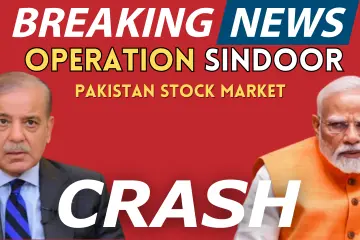





Leave a Review